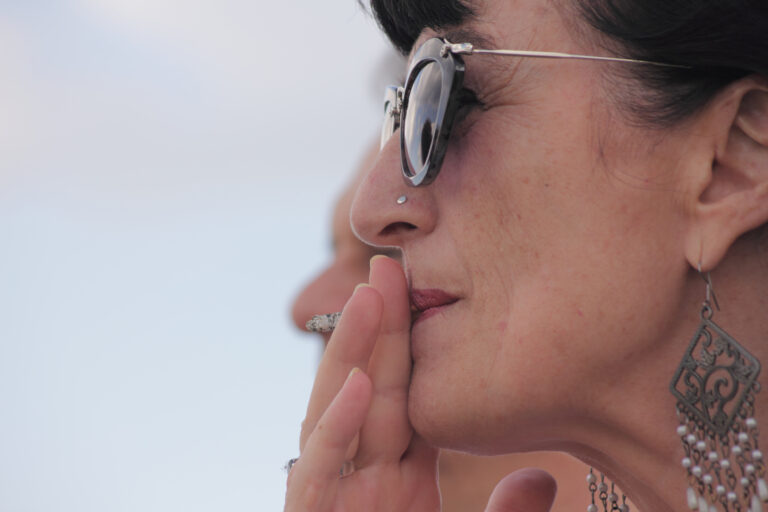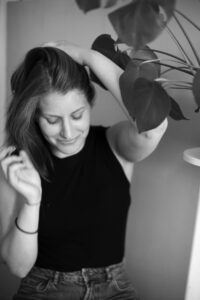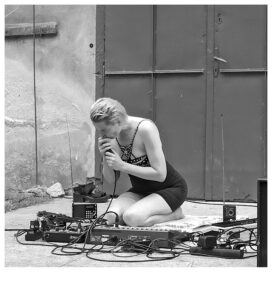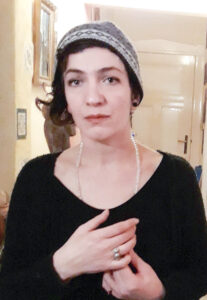Dragana Žarevac

– a visual artist born in 1959 in Belgrade, Serbia. She began exhibiting in 1979, with performances at the Student Cultural Center in Belgrade, as well as in a series of galleries in the former Yugoslavia and abroad. Her work is characterised by her personal opinions on topics of general social importance. She is the author of numerous workshops and has curated many projects. She exhibits video artwork and installations, drawings, and audio work. Amongst other places, she has exhibited in the Kunsthalle in Vienna, the Tate Modern in London, the Centre Pompidou in Paris, ZKM – Karlsruhe / Kunstwerke in Berlin, Art in General in New York and in the Museum of Contemporary Art in Belgrade. She received the International Award for Video Art from the Center for Art and Media Technology ZKM, Karlsruhe in 1998, the Golden Sphinx for her contribution to the Videomedeja Festival in Novi Sad in 1999 and the Nadežda Petrović Art Gallery Award at the 23rd Nadežda Petrović Memorial in Čačak in 2005.
Portrait of Dragana Žarevac, photo: V. Obradović, courtesy of the artist.
Freedom and knowledge
Over the course of several decades I have intimately identified with being a singer. Now I also see myself as a curious intellectual. Who am I, what is reality and what is truth? What are the laws of the world? How can I lead a comfortable life? How can I be good to myself and to others? (Which is the same because Others are the unknown in oneself). I have been wondering about these questions for years, and still want to find out and to express what I have found out regarding them to everyone who wants to listen to me. I have managed to pack all those things in my life into art123. It is very important to me that art allows the merging of completely different concepts / elements / phenomena, which is not possible in science or in other rational types of work and knowledge. I perceive learning through art as a higher level of freedom and a wider field than science.
Freedom and knowledge, or learning, are two of the highest values for me. I chose art as a profession because I believed that it would allow me to approach these values the closest. There is a difference in understanding the concept of the artist as a profession and as a personal state. In contemporary society, being an artist is a profession which requires a lot of unartistic work and at the same time often the renunciation of freedom. I see myself as an artist in terms of social status. Separating one’s identity from social status gives more freedom for both constructs to develop. The artist in me has the freedom to think, imagine and explore whichever way she wants. The artist in society listens to relationships and adapts to social trends. The field of art nevertheless allows me the greatest degree of freedom.
I have always been glad to be a woman. I am happy that I was able to give birth to a child. My bias is that I have more freedom because I am a woman, I have the freedom to be irrational, and suffer fewer consequences because of it. Since modernity has elevated the rational and suppressed the irrational, it has brought many good things, but also caused great harm. And I love and respect the irrational because it is the source of knowledge.
Because my art always speaks from the Self, all these experiences have become part of my work. I wondered how one develops from a child to an adult. This became an artwork („Evagitto“, video 1991). I wondered how living matter („Nodus Vitae“, performance, 1986) and how death function („Fields of Change“, performance, 1988). I tried to understand the creative force of erotica („Lamento da Historia“, performance, 1986). My country fell apart in a lot of suffering and blood (war trilogy: Despair, Bridge, Collateral Damage, video, 1996 – 2000). I gave birth to a child who could not breastfeed, and I found a model for healing in tradition („The Building of Skadar“, video installation, 2000). I was unhappy in my marriage („The Perfect Marriage“, video, 2001; „Entre Nous“, video installation 2007). I realised that I was capable of understanding how politics and society are reflected in micropolitics, and that the body is a monitor of these processes („Ephemeral Memorial“, „Women Women“4, „One More Turn“5, video installations 2008 – 2014). I realised that environmental awareness begins with a clean and clear mind, which respects the creative force („Discovering Territory“, „Sitting with Zoe“, video installations 2016-2019).
The pandemic years have forced us to stop and reevaluate. But stopping is also part of the process of movement. I turned to the archive and to studying the past („Expanded presence – embodied archive“6, exhibition 2021), because I needed to understand myself (and the world) again. Now I see storytelling as a form of performance, which I can use to express my experience. I recognised Beuys’s ideas once again regarding the artist as a shaman. Shamans are necessary to heal the sick planet and confused society in which repressed irrationality erupts in the form of disease and war. I will embrace my irrationality.
Text is written in collaboration with Mirjana Dragosavljević (2022).
1Illustration: Dragana Žarevac, “Wise Water”, performance, 2022, courtesy of the artist.2Illustration: Dragana Žarevac, “Watch, Listen”, video, 2021, courtesy of the artist.
3Illustration: Dragana Žarevac, “Watch, Listen”, photo in the artwork, 1984, courtesy of the artist.
4Illustration: Dragana Žarevac, “Women, Women”, video installation, 2010, courtesy of the artist.
5Illustration: Dragana Žarevac, “One More Turn”, video, 2014, courtesy of the artist.
6SEEcult.org GUIDED TOUR: Dragana Žarevac – Expanded presence – embodied archive https://www.youtube.com/watch?v=43VSEtwtpuQ.
– je vizuelna umetnica rođena 1959. godine u Beogradu u Srbiji. Izlaganje je započela 1979. performansima u Studentskom kulturnom centru u Beogradu, kao i u nizu galerijskih prostora bivše Jugoslavije i u inostranstvu. Njen rad karakteriše lični stav o pitanjima od opšteg društvenog značaja. Autorka je brojnih radionica i kustoskih projekata. Izlaže video radove i instalacije, crteže i radove u zvuku. Izlagala je, između ostalog, u Kunsthaleu u Beču[1] , Tejt Modern galeriji u Londonu, Centru Žorž Pompidu u Parizu, ZKM-u u Karlsrueu, KunstVerke u Berlinu, Art in Dženeral u Njujorku i u Muzeju savremene umetnosti u Beogradu. Dobitnica je Međunarodne nagrade za video art Centra za umetnost i medijsku tehnologiju ZKM u Karlsrueu, 1998, Zlatne sfinge za opus na Festivalu Video Medeja u Novom Sadu 1999. i Nagrade umetničke galerije Nadežda Petrović na 23. Memorijalu Nadežde Petrović u Čačku 2005.
Portret Dragane Žarevac, foto: V. Obradović, ljubaznošću umetnice.
Sloboda i znanje
Tokom nekoliko decenija intimno sam se identifikovala kao pevačica. Sada sebe doživljavam kao radoznalu intelektualku. Ko sam ja, šta je stvarnost, a šta istina? Koje su zakonitosti sveta? Kako da živim udoban život? Kako da budem dobra i prema sebi i prema drugima? (Što je isto jer Drugi su ono što Ja u sebi još uvek nije prepoznalo.) Godinama se to pitam, a i dalje želim da saznam i da to što sam saznala saopštim svima koji žele da me čuju. Sve je to u mom životu uspelo da se spakuje u umetnost123. Veoma mi je važno to što umetnost dopušta spajanje sasvim različitih pojmova / elemenata / pojava, a što nije moguće u nauci ili u drugim racionalnim vrstama rada i saznavanja. Saznavanje kroz umetnost doživljavam kao viši stupanj slobode i polje sa više širine od polja nauke.
Sloboda i znanje, odnosno saznanje su dve najviše vrednosti za mene. Odabrala sam umetnost kao profesiju zato što sam smatrala da će mi omogućiti najbliži pristup ovim vrednostima. Postoji razlika u shvatanju pojma umetnika kao profesije i kao ličnog stanja. U savremenosti, biti umetnica je profesija koja zahteva mnogo neumetničkog rada a istovremeno i često odricanje od slobode. Vidim sebe kao umetnicu na nivou socijalnog statusa. Razdvajanje identiteta od društvenog statusa daje više sloboda da se oba ta konstrukta razvijaju. Umetnica u meni ima slobodu da razmišlja, mašta i istražuje kako god želi. Umetnica u društvu osluškuje odnose i prilagođava se društvenim tokovima. Polje umetnosti je ipak ono koje mi dopušta najveći stepen slobode.
Uvek mi je bilo drago što sam žena. Srećna sam što sam mogla da rodim dete. Moja predrasuda je da imam više slobode zato što sam žena, imam slobodu da budem iracionalna, a da zbog toga trpim manje posledica. Od kada je modernost uzdigla racionalno, a potisnula iracionalno, to je donelo mnoga dobra, ali nanelo i velike štete. A ja volim i poštujem iracionalno jer je ono izvor saznanja.
Kako moja umetnost uvek govori iz mog Ja, sva ta iskustva postala su deo rada. Pitala sam se kako se razviti iz deteta u odraslog. To se oblikovalo u rad („Evagitto“, video 1991). Pitala sam se kako funkcioniše živa materija („Nodus Vitae“, performans, 1986), a kako smrt („Fields of Change“, performans, 1988). Pokušavala sam da shvatim stvaralačku snagu erotike („Lamento da Histria“, performans, 1986). Raspala mi se zemlja u velikoj patnji i mnogo krvi (ratna trilogija: „Očaj, Most, Collateral Dammage“, video, 1996 – 2000). Rodila sam dete koje nije moglo da sisa i pronašla u tradiciji model za lečenje („Zidanje skadra“, video instalacija, 2000). Bila sam nesrećna u braku („Savršeni brak“, video, 2001; „Entre Nous“, video instalacija 2007). Otkrila sam da sam sposobna da shvatim kako se u mikropolitici ogledaju politika i društvo i da je telo monitor tih procesa („Efemerni memorijal“, „Žene žene“4, „Još jedan okret“5, video instalacije 2008 – 2014). Razumela sam da ekološka svest započinje u zdravom i pročišćenom mišljenju koje poštuje stvaralačku snagu života („Otkrivanje teritorije“, „Sitting with Zoe“, video instalacije 2016 – 2019.).
Godine pandemije nametnule su zaustavljanje i preispitivanje. Ali i zaustavljanje je deo procesa kretanja. Okrenula sam se arhivi i propitivanju prošlosti („Prošireno prisustvo – otelovljeni arhiv“6, izložba 2021) jer mi je bilo potrebno da sebe (i svet) ponovo razumem. Sada pripovedanje (storytelling) vidim kao formu performansa kojim mogu da prenesem iskustvo. Ponovo sam prepoznala Bojsove ideje o umetniku kao šamanu. Šamani su neophodni da leče obolelu planetu i zbunjeno društvo u kome potisnuta iracionalnost izbija u vidu erupcija koje preuzimaju oblik bolesti i rata. Prigrliću svoju iracionalnost.
Tekst je napisan u saradnji sa Mirjanom Dragosavljević (2022).
1Ilustracija, Dragana Žarevac, “Mudra voda”, performans, 2022. Foto: Edvard Molmar, ljubaznošću umetnice.2Ilustracija, Dragana Žarevac, “Gledaj, slušaj”, video, 2021. Ljubaznošću umetnice.
3Ilustracija, Dragana Žarevac, “Gledaj, slušaj”, rad u fotografiji, 1984. Ljubaznošću umetnice.
4Ilustracija, Dragana Žarevac, “Žene, žene”, video instalacija, 2010. Ljubaznošću umetnice.
5Ilustracija, Dragana Žarevac, “Još jedan okret”, video, 2014. Ljubaznošću umetnice.
6SEEcult.org VOĐENJE: Dragana Žarevac – Prošireno prisustvo – Otelovljeni arhiv https://www.youtube.com/watch?v=43VSEtwtpuQ.


